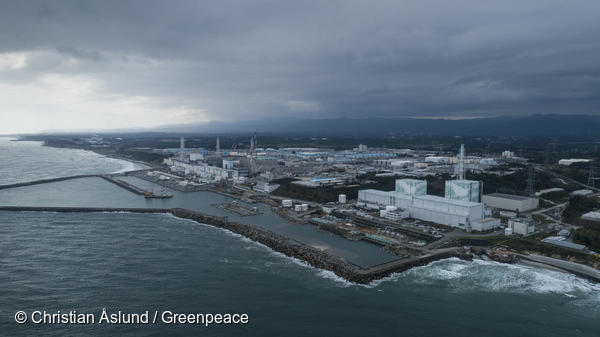Japanese citizens nationwide opposed to Pacific Ocean discharge of Fukushima radioactive water support storage and processing – new opinion poll

1 October 2019, Tokyo… Nearly four times as many Japanese citizens oppose the discharge of highly contaminated water from the Fukushima Daiichi nuclear plant into the Pacific Ocean than support it, according to a Greenpeace commissioned poll.(1) The polling of 3000 citizens in Fukushima and Niigata prefecture, as well as wider Japan, showed most expressed their support for storage of over 1 million tons of water rather than release to the Pacific Ocean. Only a small percentage approve of Government plans for discharge. Greenpeace commissioned Rakuten Insight, a pioneer in Japanese online market research to conduct the poll which was conducted between 19-24 September 2019.
The results show some slight variation in opinion between those in Fukushima and those in Niigata and wider Japan. Averaging of the poll revealed that 48.6% oppose marine discharge and 12.9% approve. In Fukushima, 15.9% approve of discharge, while 43.3% oppose. Of those who oppose discharge, nationwide 51% stated that their principal concerns were that discharging will have a negative impact, not just in Fukushima and wider Japan, but also internationally. In Fukushima, 52.9% think it will have a negative effect on Fukushima fisheries.
“We deliberately set out to try and understand the level of understanding Japanese citizens have, what they were thinking and why. They show only a small percentage approve of discharging to the Pacific ocean, and by a wider margin, most oppose. The strongest opposition comes from Niigata citizens and wider Japan. One clear message they send to the Abe government is that the opposition to discharge is not limited to Fukushima fisheries (2) and Fukushima prefecture but is nationwide. Most of those polled who are opposed to discharge show both a concern for the international impacts in the Asia/Pacific region any discharge would have and also the impact it would have on Fukushima fisheries,” said Shaun Burnie, senior nuclear specialist with Greenpeace Germany (Tokyo).
A Greenpeace report (3) in January 2019 showed that METI in 2016 deliberately excluded the option to store and process the contaminated water to remove radioactive tritium, despite receiving technical submissions from U.S. nuclear companies, and the U.S. Department of Energy. The myth promoted by the Government and TEPCO ever since is that tritium removal is not possible. The Greenpeace report also provided analysis on the failure of the ALPS processing systems, which means that over 800,000 tons of contaminated water contains dangerous radionuclides such as Strontium-90, tens to thousands of times above regulatory limits. TEPCO has committed to processing this water – but doubts remain as to how effective this will be.
As the Fukushima nuclear disaster has shown, ocean currents will disperse any future radioactive materials released not only into the Pacific, but also the East China Sea, Sea of Japan/East Sea.(4) In recent weeks, the Japanese government plans for discharge have been challenged by the South Korean government at the International Atomic Energy Agency (IAEA), while Greenpeace addressed the issue to diplomats attending the United Nations Human Rights Council in Geneva given Japan’s obligation to prevent citizens from exposure to harmful radioactivity. The issue will also be debated at the International Maritime Organization meeting of parties to the London Convention and London Protocol which opens on 7th October in London.
“The people of Japan are sending a message to the government that they will not accept deliberate radioactive pollution of the marine environment. As the polling shows, the Japanese people are concerned about the international impact of any discharge. This was never just a domestic issue. The international focus on TEPCO’s water crisis is only going to escalate in the coming months – and the Abe government has the means to end this by making the only justifiable decision – commit to no discharge and instead decide on long term storage and processing,” said Burnie.
Greenpeace commissioned the poll to include the views of 1000 Niigata citizens as they are under direct threat, including from marine contamination, from any restart of TEPCO’s Kashiwazaki Kariwa nuclear plant. TEPCO is seeking the restart of reactors 6&7, despite the existence of major seismic fault lines both adjacent and through the site. The nuclear plant is TEPCO’s last hope of remaining a nuclear plant operator.
Notes:
1 – Greenpeace commissioned Rakuten Insight is a member of the JMRA (Japan Marketing Research AssociationJapan Marketing Research Association) and the ESOMAR (Europe Society Opinion and Market Research Association); poll results (in Japanese) – https://www.greenpeace.org/japan/wp/wp-content/uploads/2019/09/b3d20ee4-%E6%B1%9A%E6%9F%93%E6%B0%B4%E6%84%8F%E8%AD%98%E8%AA%BF%E6%9F%BB%E7%B5%90%E6%9E%9C.pdf
2 – Fukushima fishermen concerned for future over release of radioactive water, Justin McCurry The Guardian, 16 September 2019, see https://www.theguardian.com/environment/2019/sep/16/fukushima-fisherman-fear-for-future-over-release-of-radioactive-water
3 – Greenpeace Germany, “TEPCO Water Crisis”, 22 January 2019, Shaun Burnie, see https://www.greenpeace.org/japan/wp/wp-content/uploads/2019/06/eef0f147-tepco_water_crisis.pdf
4 – Transport of FNPP1-derived radiocaesium from subtropical mode water in the western North Pacific Ocean to the Sea of Japan https://www.ocean-sci.net/14/813/2018/